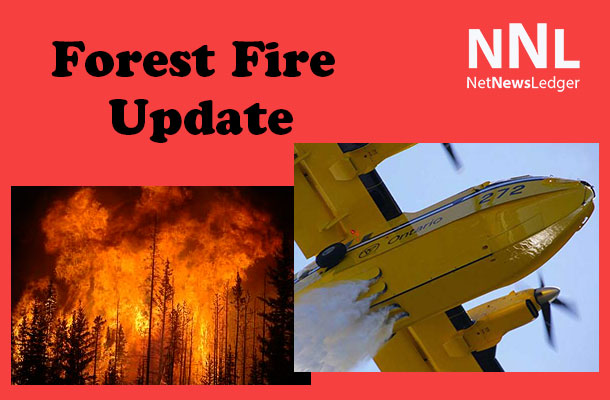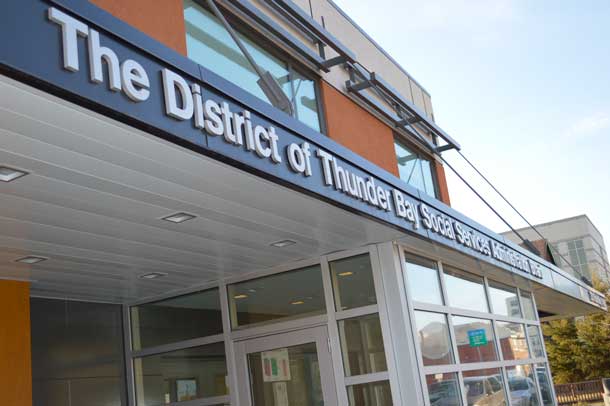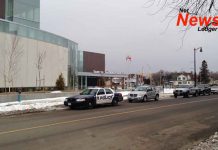 THUNDER BAY – FIRE UPDATE – Weather is impacting the wild fire conditions in Northwestern Ontario. Overall conditions have been reduced to low, with the exception being in the Northwest section of the Red Lake District.
THUNDER BAY – FIRE UPDATE – Weather is impacting the wild fire conditions in Northwestern Ontario. Overall conditions have been reduced to low, with the exception being in the Northwest section of the Red Lake District.
There was one new lightning-caused fire confirmed in the Northwest Region by the evening of May 30. Red Lake District Fire Number 13 is located about 41 kilometers northeast of Red Lake in the Coli lake area and is listed as not under control at 0.1 hectares. This brings the active fires in the Red Lake District to six, with the others burning within and north of the Woodland Caribou Provincial Park.
Two of those are fires of note including Red Lake Fire 7, located 50 kilometers northwest of Red Lake in the park has four Type 2 crews working to consolidate the eastern flank of the lightning-caused fire which is currently listed as not under control at 1,256 hectares. Red Lake Fire 10, another lightning-caused fire located on the northeast side of Woodland Caribou has seven crews committed to the fire line, establishing hose lines around the fire. It is listed as not under control at 650 hectares in size.
Sioux Lookout District has declared two fires out. Sioux Lookout Fire 15 was a lightning-caused fire located about 10 kilometers northeast of Sioux Lookout. Its final size was 16 hectares. Sioux Lookout 18 in Kitchenuhmaykoosib Inninuwug, located about 435 kilometers north of Sioux Lookout, was declared out at 1.0 hectare in size.
Wild Fire Update – Kenora
Kenora District continues winding down two fires and monitoring a prescribed burn. Kenora Fire 28 is now listed as under control at a size of 187.3 hectares. At its height this fire was challenging and required aggressive air and ground attack, closing Shoal Lake Road for several hours. It is now under control and only four hot spots were found by infrared scanning and crews are retrieving hose from the fire line. Kenora Fire 29, a lightning-caused fire located 19 kilometers south of Kenora is under control at 4.5 hectares in size and crews are pulling hose line from this fire as well. A prescribed burn which involved several islands in the Lake of the Woods conservation reserve is being monitored with some smoldering reported on one of the islands.
Fort Frances and Thunder Bay Districts continue to monitor island fires, one in Quetico Park and one west of Armstrong. Assessments on these fires indicate the fires have burned across the islands and are smoldering.
The forest fire hazard is low across most parts of the region with one area of moderate in the northwest sector in the Red Lake District. Temperatures are expected to remain below seasonal for the next couple of days and frost is a possibility again tonight.
Out of Province Deployment
Ontario Agency Representatives in the Yukon are stationed in Beaver Lake, Dawson, Watson Lake and Whitehorse and Ontario FireRanger crews have finished all briefings and have been deployed throughout the Territory on assignments.
Ontario firefighters and overhead staff in Alberta are positioned in the wildfire management areas across the northern sectors of the province including Fort Chippewa, Fort McMurray, High Level, Lac La Biche, Peace River, Slave Lake and Whitecourt. Some are on active duty on fires and some are stationed at bases for initial attack on new fires.
Current facts on the wildfires in Northern Alberta.
Fire Update: Friday, May 29 at 3:30pm
- In the last 24 hours there have been eight new wildfires.
- ** Currently, Alberta has 41 wildfires, five of which are considered out of control. **
- 748 fires and 43,358 hectares have burned since April 1.
- The wildfire outlook in Alberta remains severe through to at least the end of this week.
- The Alberta Emergency Management Agency and the Alberta government are closely monitoring the situation.
- Approximately 1,700 firefighters, 159 helicopters and 28 airtankers are positioned across the province to fight wildfires.
- Another 37 firefighters are being imported from British Columbia today. This is in addition to the 273 firefighters imported since last Friday.
- The Cold Lake fire is five kilometers from CNRL infrastructure, and 20 km from Cenovus infrastructure. There is no imminent risk to their infrastructure.
- While cooler, wet weather is expected for parts of the province, this will not reduce the wildfire hazard in much of Northern Alberta.
Evacuations
- All evacuation orders have been lifted.
- Reception centres are now closed.
- About 4,800 evacuees have returned home.
- Cenovus and CNRL voluntary evacuations remain in effect.
Air quality
- Air quality in much of the northern regions of the province is affected by the smoke.
- Alberta Health Services’ Precautionary Air Quality Advisories are in effect for the entire North and Edmonton areas.
- The Cold Lake-specific Air Quality Advisory issued by AHS on May 25 remains in place.
- These advisories alert Albertans to the health concerns and risks associated with smoky air conditions, and advise on important steps they can take to protect themselves and their loved ones.
- These advisories will remain in place until further notice.
- Albertans should visit the Alberta Health Services page for the latest information on air quality advisories.
Things to Know
- The wildfire outlook in Alberta continues to be severe.
- Due to improved conditions and the efforts of our firefighters, the provincewide fire ban has been lifted. However, there still are fire bans in many areas of the province, including the north.
- All Albertans are asked to respect the fire bans and fire restrictions that are in place across the province, to listen to emergency officials, and to download the Alberta Emergency Alert app and the Alberta Wildfire app to stay on top of the latest information.
- If Albertans are unsure of fire restrictions in their area, please visit Alberta Fire Bans.
- We encourage Albertans who have been out of their homes to contact their insurance companies right away.
There are currently 74 personnel in the Yukon and 143 personnel in Alberta.
The Aviation, Forest Fire and Emergency Services program is reminding people that they are responsible for safe outdoor fire management and must follow guidelines set out in the Forest Fires Prevention Act of Ontario including no day burning of brush or grass fires. Campfires are to be tended at all times and put out before leaving.
For further tips on how to be FireSmart, visit ontario.ca/firesmart
For more information about the current fire situation and the active fires map, ontario.ca/forestfire
The Northwest Region Fire Information Hotline is available for general information updates – 1-888-258-8842
Report forest fires by calling 310-FIRE (3473).






